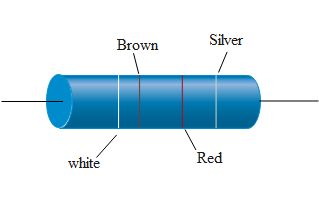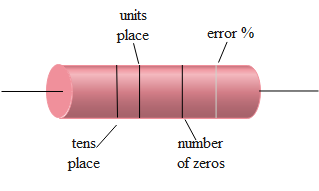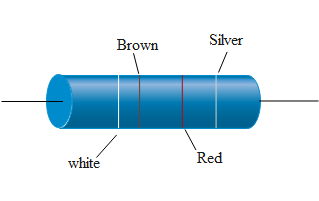
In the figure, a carbon resistor has bands of different colors on its body as mentioned in the figure. The value of the resistance is:

A. $2.2k\Omega $
B. $3.3k\Omega $
C. $5.6k\Omega $
D. $9.1k\Omega $

Answer
557.4k+ views
Hint: Carbon resistors are made up of solid cysteine resistive elements with embedded leads or metal end caps to which the lead wire is attached. the value of the (characteristic) of the resistor is identified according to the 4 straps embedded over the resistance. Each strap and color have their meaning.
Complete answer:
When we study the resistance identification of the resistor we have to decode the values according to the color of the strap and its position. The coding of the color is done from left to the write strap. The ${{1}^{st}}$ three straps indicate the value of the resistance, and the ${{4}^{th}}$ strap stands for the percentage of error which can occur while using the resistor in a circuit. This would be more clearly understood from the diagram shown here,
(The color of the straps in this diagram is random they are just for expansion)

The ${{1}^{st}}$ three straps which indicate the value of the resistance have their meaning. The ${{1}^{st}}$ two straps show the unit and tens place of the resistance value and the ${{3}^{rd}}$ strap denotes the number of zeros. The ${{4}^{th}}$ strap stands for the percentage of error which can occur while using the resistor in a circuit.
The list of color code of resistance is shown here,
For ${{1}^{st}}$ three straps
For error detection

So from the value of the color code given in the table the resistance of the resistor given in the question which is shown in the above diagram will be,
$\begin{align}
& R=9100\pm 10\text{%}\\
& \Rightarrow R=9.1\times {{10}^{3}}\pm 10\text{%}\\
& \therefore R=9.1k\Omega \\
\end{align}$
So, the value of resistance is $9.1k\Omega $ with an error occurrence percentage of ten percent.
Thus the correct option for the question is Option D.
Note:
The body of the resistor is isolated by the insulators like plastic, plastic, or fibers. This is done so that there is no chance of electric shock. These resistors are used in circuits like on a breadboard in laboratories. These resistors are mainly formed to deal with the DC sources.
Complete answer:
When we study the resistance identification of the resistor we have to decode the values according to the color of the strap and its position. The coding of the color is done from left to the write strap. The ${{1}^{st}}$ three straps indicate the value of the resistance, and the ${{4}^{th}}$ strap stands for the percentage of error which can occur while using the resistor in a circuit. This would be more clearly understood from the diagram shown here,
(The color of the straps in this diagram is random they are just for expansion)

The ${{1}^{st}}$ three straps which indicate the value of the resistance have their meaning. The ${{1}^{st}}$ two straps show the unit and tens place of the resistance value and the ${{3}^{rd}}$ strap denotes the number of zeros. The ${{4}^{th}}$ strap stands for the percentage of error which can occur while using the resistor in a circuit.
The list of color code of resistance is shown here,
For ${{1}^{st}}$ three straps
| Colour code | Value |
| Black | 0 |
| Brown | 1 |
| Red | 2 |
| Orange | 3 |
| Yellow | 4 |
| Green | 5 |
| Blue | 6 |
| Violet | 7 |
| Grey | 8 |
| White | 9 |
For error detection
| Colour code | Value |
| Gold | 5% |
| Silver | 10% |
| Colour less | 15% |

So from the value of the color code given in the table the resistance of the resistor given in the question which is shown in the above diagram will be,
$\begin{align}
& R=9100\pm 10\text{%}\\
& \Rightarrow R=9.1\times {{10}^{3}}\pm 10\text{%}\\
& \therefore R=9.1k\Omega \\
\end{align}$
So, the value of resistance is $9.1k\Omega $ with an error occurrence percentage of ten percent.
Thus the correct option for the question is Option D.
Note:
The body of the resistor is isolated by the insulators like plastic, plastic, or fibers. This is done so that there is no chance of electric shock. These resistors are used in circuits like on a breadboard in laboratories. These resistors are mainly formed to deal with the DC sources.
Recently Updated Pages
Why are manures considered better than fertilizers class 11 biology CBSE

Find the coordinates of the midpoint of the line segment class 11 maths CBSE

Distinguish between static friction limiting friction class 11 physics CBSE

The Chairman of the constituent Assembly was A Jawaharlal class 11 social science CBSE

The first National Commission on Labour NCL submitted class 11 social science CBSE

Number of all subshell of n + l 7 is A 4 B 5 C 6 D class 11 chemistry CBSE

Trending doubts
Differentiate between an exothermic and an endothermic class 11 chemistry CBSE

10 examples of friction in our daily life

One Metric ton is equal to kg A 10000 B 1000 C 100 class 11 physics CBSE

Difference Between Prokaryotic Cells and Eukaryotic Cells

1 Quintal is equal to a 110 kg b 10 kg c 100kg d 1000 class 11 physics CBSE

State the laws of reflection of light




